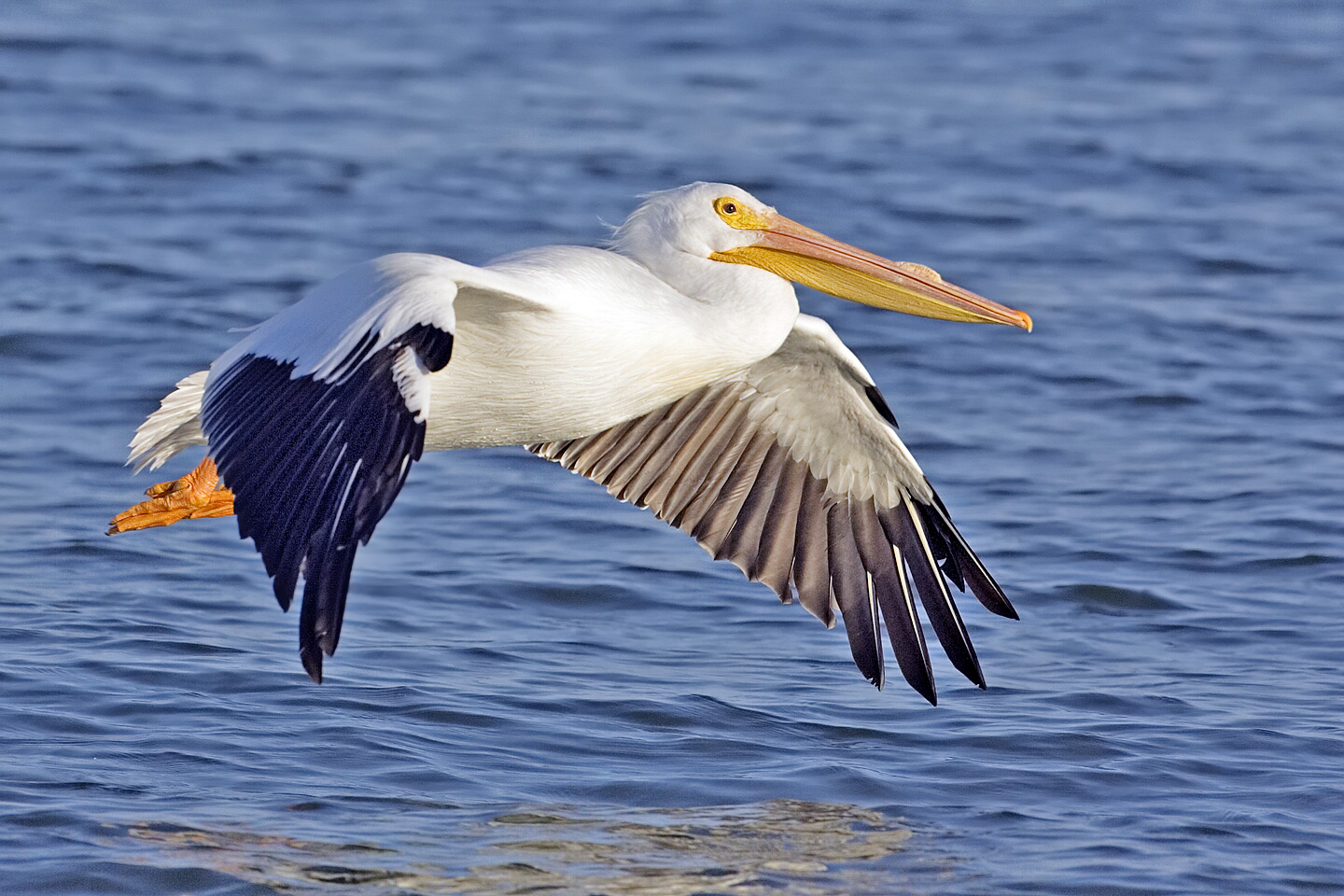- American White Pelican
Taxobox
name = American White Pelican
status = LC | status_system = IUCN3.1

image_width = 250px
image_caption = Adult
regnum =Animal ia
phylum = Chordata
classis =Aves
ordo = Pelecaniformes
familia =Pelecanidae
genus = "Pelecanus "
species = "P. erythrorhynchos"
binomial = "Pelecanus erythrorhynchos"
binomial_authority = Gmelin,1789 The American White Pelican ("Pelecanus erythrorhynchos") is a very large (50"–70") white
bird with black wing tips and a long, wide orange bill. It has a wing span of up to 110 inches and typically weigh about 7 kg (15.5 lb). It's binomial name combines "Pelecanus", theLatin for pelican, with "erythrorhynchos", derived from the Greek words "erythros" meaning "red", and "rhynchos" meaning "beak".Habits
Unlike the
Brown Pelican , the American White Pelican does not dive for its food. Instead it feeds while swimming. [ [http://www.mbr-pwrc.usgs.gov/id/framlst/i1250id.html American White Pelican ] ] Each bird eats more than 4 pounds of fish a day, mostlycarp ,chub s, shiners,yellow perch ,catfish , andjackfish .Range
White Pelicans nest in colonies of several hundred pairs on islands in remote brackish and freshwater lakes of inland
North America . The most northerly nesting colony can be found on islands in the rapids of theSlave River between Fort Fitzgerald,Alberta andFort Smith, Northwest Territories . About 10-20% of the population usesGunnison Island in theGreat Basin 'sGreat Salt Lake as a nesting ground. The female lays 2 or 3 eggs in a shallow depression on the ground. Both parents incubate.They winter in central
California and along thePacific coast ofGuatemala ; also along the shores of theGulf of Mexico , itsbay s and estuaries and along the Mississippi river at least as far north as St. Louis.Management concerns
This species is protected by the
Migratory Bird Treaty Act of 1918 . It has theCalifornia Department of Fish and Game protective statusCalifornia Species of Special Concern (CSC).Habitat loss is the largest known cause of nesting failure, with
flooding anddrought being recurrent problems. Predation bycoyote s,raven s andgull s is common. Human-related losses include entanglement in fishing gear,boating disturbance andpoaching as well as additional habitat degradation. [citation | last = Blood| first = Donald A.| authorlink = | coauthors = Michael Hames, Arifin Graham, Richard Pawlas, Laura Friis | title = American White Pelican| work = Wildlife in British Columbia at Risk| publisher = Providence of British Columbia Ministry of Environment, Lands and Parks| date = October 1993| url = http://wlapwww.gov.bc.ca/wld/documents/pelican.pdf| format = PDF| doi = | isbn = 0-7726-7466-3| accessdate = 2008-02-20]ee also
*
Bird colony
*Pelican Notes
References
* Database entry includes justification for why this species is of least concernExternal links
* [http://ibc.hbw.com/ibc/phtml/especie.phtml?idEspecie=219 American White Pelican videos] on the Internet Bird Collection
* [http://www.nature.org/animals/birds/animals/pelican.html The Nature Conservancy works to protect habitat for the American white pelican and other species around the world]
* [http://www.sdakotabirds.com/species/american_white_pelican_info.htm South Dakota Birds - American White Pelican Information and Photos]
* [http://www.flickr.com/groups/birdguide/pool/tags/Pelecanus%20erythrorhynchos Pictures from 'Field Guide' page on Flickr]
* [http://www.bird-stamps.org/cspecies/1500600.htm Stamps] (forBritish Virgin Islands ,Canada ,Cuba ,Turks and Caicos ) - with RangeMap
* [http://vireo.acnatsci.org/search.html?Form=Search&SEARCHBY=Common&KEYWORDS=American+White+Pelican&showwhat=images&AGE=All&SEX=All&ACT=All&Search=Search&VIEW=All&ORIENTATION=All&RESULTS=24 American White Pelican photo gallery] VIREO
Wikimedia Foundation. 2010.
